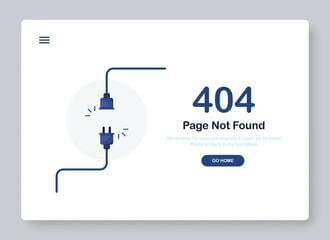What Is A Broken Link?

A broken link is a hyperlink coded into a webpage that returns an error message instead of directing users to the intended destination. Some examples of common broken link errors you may encounter include the following:
- 404 Page Not Found Error
This means the webpage previously connected to the link has been deleted or removed.
- 410 Gone Error
This error code means the content was intentionally deleted permanently.
- 500 Internal Server Error
This suggests a coding or server issue is preventing access to the intended web page.
No matter what the specifics of the error message may be, broken links share the fact that they fail to send users to relevant content. These links were directed somewhere useful in the past, but because websites frequently add and remove pages, over time, some links break. By finding and fixing broken links, you can restore value for users in terms of their web browsing experience.
What Is Broken Link Building?
Broken link building is a strategic SEO process that earns backlinks while enhancing user experience. You find broken hyperlinks on other websites that produce error messages. Then, you create and optimize useful, relevant content to replace the missing information those broken links intended to reach.

This adds value for the site’s visitors and solves problems for site owners. In return, those sites link to your content instead of the broken URL, granting you an authoritative backlink. When done correctly, broken link building offers an ethical way to win powerful backlinks from reputable sites relevant to your target niche.
Does Broken Link Building Still Work?
Absolutely! While other link building techniques have faded in their SEO value over the years, broken link building remains an effective method for earning high quality backlinks.
In fact, broken link building can work even better today, thanks to the constantly evolving nature of websites. Sites add and remove pages frequently, meaning new broken links appear all the time for you to find and fix.
Additionally, site owners are often grateful when you inform them about broken links on their site. If you provide a valuable replacement page for the broken link, most reputable sites will happily link back to your content.
What Are The Benefits Of Broken Link Building?
The strategic value of broken link building stems from several key benefits:
- You earn backlinks from authority sites when you fix their broken links, since webmasters readily link out to viable replacement content.
- The links you acquire occur naturally as solutions to real user experience issues. This avoids risky over-optimization.
- Broken link building opportunities lets you expand your site's topical footprint by creating content that fixes dead pages around relevant subjects.
- Because websites continuously add and remove pages, new broken link opportunities arise all the time, making this an enduring link building tactic.
Broken link building enables you to organically enhance your visibility and authority by remedying problems for website visitors and site owners alike. The value it provides earns goodwill and coveted backlinks.
How To Do Broken Link Building
Now that you understand the value of broken link building, let’s get into the step-by-step process for finding prospects and earning backlinks.
- Look for broken pages with backlinks
- Examine link prospects
- Create a replacement page
- Identify Outreach Contacts
- Outreach
1. Identify Broken Pages with Backlinks
The first step is discovering currently broken pages that have backlinks pointing to them. These incoming links indicate that the broken page held value in the past, making site owners more likely to link out to your replacement content.

Here's what to look for when finding broken, previously-linked pages:
- Competitors’ Broken Pages with Backlinks
Use backlink analysis tools to identify your top competitors’ most linked-to pages. Check each popular page for errors to find broken links still earning significant links.
When you locate unusable competitor pages attracting external links, document the referring domains linking to those defective pages. Create valuable replacement content suited for the target audience. Then, outreach to each site driving links to the broken competitor page.
Show them the issue and suggest swapping your working content as the new destination for their link. This allows you to fix issues while benefiting from your rivals’ existing link equity from otherwise wasted backlinks.
- Broken Pages About A Particular Topic
Uncovering topic-specific broken pages provides targeted link prospects. To extract them:
- Conduct niche site searches like site:nytimes.com “bread recipes” “404 page” to uncover broken topic pages on specific domains.
- Try wider inurl searches like inurl:sourdough “page not found” to reveal broken pages about your topic across the web.
- Analyze the source sites linking to each topic-relevant broken page.
- Create on-topic replacement content around the expected theme to resolve each site’s user experience.
Matching your content’s topic to each broken page site by site enables precise alignment for relevance and value. This topical relevance drives linking potential.
- Broken Links On Resource Pages
Many websites feature resource pages with content recommendations or lists of related external links. These hubs aim to provide value but often suffer from link rot. To leverage them:
- Target sites publishing frequently-updated resource pages like news outlets and special interest blogs.
- Analyze site-specific lists of top stories, must-read content, best product reviews, etc.
- Click each external link to identify rotten destinations producing errors.
- For dead links still earning referral traffic, create useful replacements suited to what visitors expected.
- Inform site owners of the broken experience for their readers and provide your improved content to restore their reference value.
As sites strive to deliver current, high-quality resource content, broken links persist—and so do backlink opportunities by resolving them.
2. Examine Link Prospects
Thoroughly vet your prospects to identify and prioritize the most valuable link earning opportunities:
- Check Link Quality
Assessing link quality allows you to prioritize the most valuable prospects:
- Who is referring the link? Links from reputable, authoritative websites demonstrate higher quality. Prioritize resources like major news outlets and industry publications.
- Analyze placement and context. Links shown prominently in on-topic positions indicate relevance. Footer links often show lower editorial consideration.
Vetting link quality determines the true value of discovered links to broken pages. Though broken, links from reputable sites revealed editorially hold the greatest potential for replacements to earn a reconstituted link. Focus efforts on prominent links from respected sites for the highest prospect yield.
- Examine Link Reasons
Determining why original links were placed allows proper realignment:
- Why was the initial content linked? Match your replacement to the informational motivations and value-add of the broken page to recreate link suitability.
- Is the link topically on-theme? Off-topic links show lower relevance despite other factors.
Assessing the purpose and topical appropriateness behind broken links gives insight into site owners’ content goals. This reveals what characteristics made the initial page link-worthy. Recreating those editorial values in your replacement content boosts linking potential for a relevant, seamless transition site visitors appreciate.Examining link quality and contextual relevance filters higher-potential opportunities worth your outreach efforts. Match your replacement content to both the value and thematic expectations of past links to boost backlink potential.
- Create A Replacement Page
With a quality prospect identified, craft valuable content site owners can confidently link instead of broken pages:
- Create An Outline
Craft an outline mirroring what made the broken page originally link-worthy:
- Analyze the topic of the broken page to identify focus expectations from visitors and sites.
- Structure your outline with matching headers and subpoints to replicate relevance.
- Ensure covered topics and themes align to recreate the editorial, informational, or resource value lost through the broken experience.

Shaping your content with an outline identical to site owners’ thematic hopes for the initial broken page is crucial. This demonstrates your replacement seamlessly provides the same user experience they intended to deliver visitors before errors interrupted flow. Matching their content shaping earns confidence. - Add Linkable Points
Make your content link-friendly to attract editorial citations:
- Incorporate properly attributed statistics, quotes, and data that aligns with your topic focus to encourage links.
- Cite and link to reputable external resources to demonstrate your command over the subject matter.
- Include shareworthy defining examples and factual evidence to support your outlined topic points.
- Structure subheaders and highlighted points within your text to make portions easily quotable with contextual links directing back.
Packing pages with digestible data points, citable resources, and link-worthy sections enables greater visibility and backlink potential as replacements for once well-trafficked content. - Improve Your Content
Refine your replacement content to better the broken version:
- Edit page copy to incorporate richer information, better clarity, and an easy-to-follow narrative flow around your outlined topic.
- Add visual assets like charts, videos, or graphics to create more engaging experiences cited through links.
- Check page speed and mobile optimization to create seamless visibility across devices lacking in the broken version.
Refining end-to-end usefulness, presentation, and accessibility boosts confidence for referrers considering your improved replacement. Deliver better performance than the broken version in all areas possible to attract links.Creating an outlined framework citing supportive resources earns relevance. Pack your page with linkable points site owners can editorially cite. This attracts links to better serve site visitors with a truly upgraded alternative.
- Identify Outreach Contacts
Successfully connecting your replacement content to site owners requires identifying proper outreach contacts:

- Target sites’ About or Contact pages to find emails of editors, content managers, website admins, and other digital media decision makers.
- Leverage LinkedIn to uncover contacts associated with the website, cross-referencing editorial hierarchies.
- Email the generic editor/webmaster contact if no specific individual is listed but follow up by phone to uncover better contacts.
- Securing the names and contact information for personnel responsible for site content and architecture decisions ensures your outreach messages reach the proper authority for approving the broken link substitution.
Cast a wide initial net, then funnel down into direct contacts for personalized discussion around implementing your tailor-made broken link solution.
- Outreach
Connecting replacement content to broken link opportunities requires tailored, transparent outreach:
- Introduce yourself and explain the discovered broken link, noting the impairments to their user experience.
- Spotlight your content's topical alignment as an optimized substitute in both focus and added value over what the previous broken page provided before.
- Emphasize performance improvements too like better information depth, presentation, and accessibility now brought to their readers.
- Welcome open feedback during the evaluation as you aim to earnestly help, not seek self-benefit. Follow up politely as needed.
This showcases your genuine, constructive solution-building motivation targeting a real site issue. Combined with showcasing topic match and user experience upgrades, this outreach style optimizes substitution approval to upgrade broken doors into quality links.
Final Thoughts
Broken link building remains a proven, white hat link building tactic in 2024 and beyond. Despite some extra effort upfront, fixing broken links provides value to site visitors and site owners alike. By following the best practices outlined here for finding prospects and creating useful replacement content, you can continually earn high quality backlinks through broken link building.
